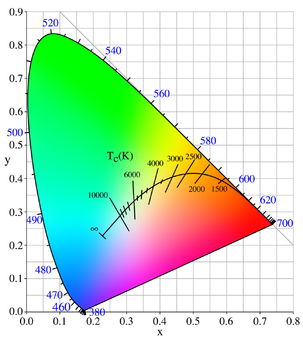Green star (astronomy)
From Wikipedia, the free encyclopedia
In astronomy, a green star
is a white or blue star that appears green due to an optical illusion.
There are no truly green stars, because the color of a star is more or
less given by a black-body spectrum
and this never looks green. However there are a few stars that appear
green to some observers. This is usually because of the optical illusion
that a red object can make nearby objects look greenish. There are some
multiple star systems, such as Antares, with a bright red star where this illusion makes other stars in the system look green.
Finally I come to a book that says, "Mathematics is used in science
in many ways. We will give you an example from astronomy, which is the
science of stars." I turn the page, and it says, "Red stars have a
temperature of four thousand degrees, yellow stars have a temperature of
five thousand degrees . . ." -- so far, so good. It continues: "Green
stars have a temperature of seven thousand degrees, blue stars have a
temperature of ten thousand degrees, and violet stars have a temperature
of . . . (some big number)." There are no green or violet stars, but
the figures for the others are roughly correct. It's vaguely right --
but already, trouble! That's the way everything was: Everything was
written by somebody who didn't know what the hell he was talking about,
so it was a little bit wrong, always! And how we are going to teach well
by using books written by people who don't quite understand what
they're talking about, I cannot understand. I don't know why, but the
books are lousy; UNIVERSALLY LOUSY!
Contents
Why stars are not green

The colors of black-body radiation and most stars lie on the Planckian locus (the curved black line near the center of the diagram), with the corresponding temperature given in kelvins (in CIE 1931 x,y space). The spectral (rainbow) colors lie on the outer curved part of the diagram, with their wavelength given in nanometers.
The (blackbody) colors of stars are sometimes confused with the colors of the spectrum, as in the textbook mentioned by Feynman in the quote above. The spectral (rainbow) colors are those on the curved part of the boundary of the diagram on the right. As can be seen, the red, orange, yellow and blue rainbow colors happen to be much the same as blackbody colors. However, stars whose peak emission is green light also emit much red and blue light, and the human visual system happens to interpret this mixture of colors as whitish rather than green. So the fact that some spectral colors appear as star colors is more a quirk of human color vision than a property of stars: if one uses an instrument such as a spectroscope that is better at distinguishing wavelengths of light, then all spectral colors look completely different from star colors. All sufficiently hot stars look about the same shade of blue (and not violet as claimed in some popular accounts). The reason for this is that at sufficiently large temperatures (above about 20000 degrees) all blackbody spectra look about the same in visible light, though they can differ lot at shorter wavelengths. Although their maximum output at visible wavelengths is at violet, they put out enough light at other wavelengths to look light blue: the color at the end of the Planckian locus rather than the color at the end of the spectrum.
Human color vision is in fact more complicated than suggested by the explanation above, and in particular the perceived color of an object depends not only on the light it emits, but also on the colors of nearby objects. For example, a blue object close to a red object may appear somewhat greenish; this effect accounts for many apparently green stars.
Strictly speaking, green stars are very unlikely rather than completely impossible. The spectrum of a star is not quite a black body spectrum but is altered by absorption and emission lines of the elements and compounds in it. It is conceivable that among the 1022 stars in the visible universe there are a few with such unusual structures and chemical compositions that their color is visibly altered from a black-body color, but no examples of this are known.
Objects that resemble green stars
Although there are no truly green stars, there are many astronomical objects that can sometimes appear to be green stars. This section lists some of them.Multiple stars
...there is no instance of an isolated deep blue or green star; these colors are apparently confined to the compound stars.
Nebulae
Some planetary nebulae glow green, especially if they contain oxygen. These nebulae, or stars within them, may appear to be green stars. Some examples are the planetary nebulae NGC 6572, NGC 6826 and NGC 7009.Beta Librae (Zubeneschamali)
Another mystery concerns the fact that this white star has so often
been described as "greenish" or "pale emerald". Olcott refers to it as
"the only naked-eye star that is green in color" while T.W.Webb refers
to its "beautiful pale green hue". Star colors are strangely elusive, of
course, and there are many such discrepancies in the guidebooks, but
modern observers generally agree that the only stars which definitely
appear green are the close companions to red stars such as Antares
itself.
Uranus
The planet Uranus, occasionally mistaken for a star, can appear greenish as it has a lot of methane that absorbs red light.The Sun
The Sun can sometimes appear as a green spot for a second or two as it is rising or setting: this is known as green flash. Roughly speaking, the red light from the Sun is blocked by Earth, the blue light is scattered by the atmosphere, and the green light is refracted by the atmosphere to the observer. A similar effect can occasionally be seen with other astronomical objects such as the moon and bright planets.False color images
Astronomical images are sometimes printed in false colors, which can make stars look green.Flying objects
Aircraft have a green navigation light on their starboard wing.References
- Burnham, Robert (1978). Burnham's celestial handbook: an observer's guide to the universe beyond the solar system 2. New York: Dover. ISBN 9780486235684.
- Feynman, Richard (1997). Surely you're joking, Mr. Feynman!. W. W. Norton & Company. ISBN 978-0-393-31604-9.














Comments
Post a Comment